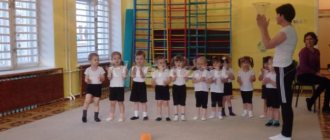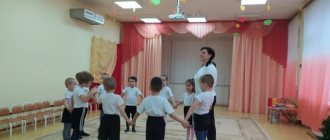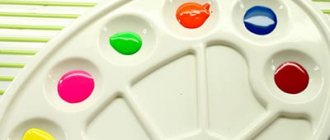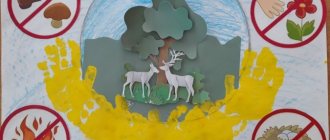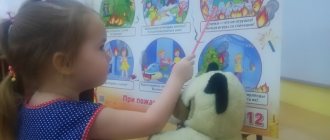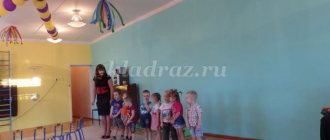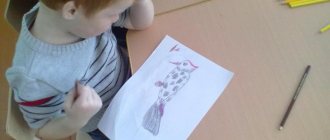Junior group. Early childhood, nursery. Children 1-4 years old
Features of physical education classes for young children FEATURES OF PHYSICAL CLASSES FOR EARLY CHILDREN Abstract: the article discusses the system of work on physical education of young children. The emphasis is on the physiological characteristics of children of this age. Key words: early age,…
Abstract of the GCD on physical education for the second group of early age “Teddy bear visiting the guys” Summary of GCD on physical education for the second group of the early age. Topic: “Teddy bear visiting the kids” Goal: Develop children’s motor activity Objectives: -Improve standing long jump on two legs, practice crawling on all fours, crawl under an arc,…
Card index “Physical education in the second junior group”
Abdulova Dzhume Sirazhutdinovna
Card index “Physical education in the second junior group”
Lesson 1
Tasks. Practice walking between objects, running in all directions; in maintaining stable balance when walking on increased support; in jumping.
Part 1. Walking in a column one at a time; walking between objects (cubes, skittles placed along the hall; the distance between them is 1 m. Children in a column, one at a time, walk between objects in a “snake” manner. When the last child in the column passes between the objects, the command is given to run in all directions. The task is repeated twice.
Part 2. General developmental exercises with a hoop.
1. I. p. – feet at the width of the foot, hoop with a grip from the sides, below. Raise the hoop up, look out the “window”, lower the hoop down, return to the starting position (5 times).
2. I. p. – standing with feet hip-width apart, hoop in bent arms near the chest, grip of arms from the sides. Sit down, bring the hoop forward, rise, return to the starting position (4 times).
3. I. p. - feet shoulder-width apart, hoop in bent arms near the chest. Raise the hoop up, lean to the right (left); straighten up, return to the starting position (2-3 times).
4. I. p. - standing in a hoop, legs slightly apart, hands on the belt. Jumping on two legs in a hoop, alternating with a short pause.
Main types of movements.
Equilibrium. Walking on the board sideways with an extended step, hands on the belt, at a moderate pace. At the end of the bench, step down and step forward. The teacher provides assistance and insurance (2-3 times).
Jumping from bump to bump. Along the opposite sides of the hall there are 5-6 hoops at a distance of 50 cm from one another in a checkerboard pattern. After the teacher shows and explains the task, the children line up in two columns and perform jumps from hoop to hoop in a continuous manner. The teacher makes sure that the children push off energetically from the floor and land on bent legs, maintaining the required distance.
Outdoor game "Hen and Chicks".
3rd part. Game "Let's find the chicken."
Lesson 2
Tasks. Exercise walking with stepping, developing coordination of movements; repeat tasks in jumping and throwing a ball.
Part 1. Walk in a column one at a time, stepping over the cords with your right and left feet alternately. The cords are placed at a distance of 30–35 cm from one another (child’s step). The main thing is that there are no extra steps. Then the command is given to run in all directions, using the entire area of the hall.
Part 2. General developmental exercises.
1. I. p. - legs at the width of the foot, arms along the body. Raise your arms up to your sides, clap your hands above your head; lower your arms, return to the starting position (9 times).
2. I. p. - feet width apart, hands behind the back. Sit down, clap your hands in front of you; straighten up, return to the starting position (4 times).
3. I. p. – feet shoulder-width apart, arms to the sides. Tilt to the right, touch your right leg with your palm, straighten up, arms to the sides. The same to the left (4–5 times).
4. I. p. - feet shoulder-width apart, hands on the belt. Turn to the right, arms to the sides; return to the starting position. The same to the left (3 times).
5. I. p. – legs slightly apart, arms at random. Jump on two legs with a turn to the right, return to the starting position. The same to the left (3-4 times).
Main types of movements.
Jumping "Across the Ditch" In the hall, on both sides of the cords there are 4–5 “grooves” (30 cm wide), one parallel to the other. Children in two columns perform jumps on two legs from “groove to groove”: waving their arms, they energetically push off from the floor and land on half-bent legs.
The exercise is repeated 2-3 times.
Funny Ball Throwing. After performing the jumps, the children take one ball from the box (basket). The children stand in a semicircle, or in two ranks, or randomly throughout the hall. The teacher shows and explains the exercise: “Feet shoulder-width apart, ball in bent arms near the chest. You need to throw the ball at the toes, catch it with both hands after bouncing off the floor, trying not to press it to your chest.” Children take their starting position and throw balls at a signal. After all the children have caught the balls, the signal is given for the next throw. The exercise is repeated 8-10 times.
Outdoor game “Birds in nests”.
3rd part. Walking in a column one at a time.
Lesson 3
Tasks. Practice walking and running in a circle, turning at a signal; repeat rolling balls, developing dexterity and eye; crawling in a straight line.
Part 1. Walking and running around the cubes with a turn in the other direction at the teacher’s signal (cubes according to the number of children). After walking and running exercises, the teacher invites each child to take a cube. Formation in a circle.
Part 2. General developmental exercises with a cube.
1. I. p. – legs at the width of the foot, cube in the right hand below. Raise your arms up through your sides, transfer the cube to your left hand, lower your hand. The same with the left hand (3-4 times).
2. I. p. – feet shoulder-width apart, cube behind back in right hand. Bend over, put the cube on the floor, straighten up; bend over, take the cube in your left hand, straighten up. And so on alternately (4 times).
3. I. p. - sitting, legs crossed, cube in right hand. Turn to the right, place the cube at the toes; straighten up, hands on your waist. Turn to the right, take the cube, transfer it to your left hand. The same to the left (3 times).
4. I. p. – legs slightly apart, arms at random, cube on the floor. Jumping on two legs around the cube in both directions (2-3 times).
Main types of movements.
“Ride between objects.” Rolling balls between medicine balls (4-5 pieces, lying at a distance of 1 m from each other. The ball moves like a “snake” between objects - children push it with two hands folded in a “boat”. At the end of the exercise, you need to take the ball in your hands and lift it over your head and stretch.
Crawling in the forward direction “Funny Bugs”. Crawling on a gymnastic bench on your hands and knees - fast, like bugs. It is performed in-line in two columns (2–3 times).
Outdoor game "Frogs".
3rd part. Walking in a column one at a time.
Lesson 4
Game exercises on the covered and mastered material.
1. "Beetles." At the teacher’s signal: “The beetles have flown!” - the children scatter all over the hall. At the signal: “The beetles are resting,” the children lie on their backs and move their legs and arms, as if moving their paws. Then the “bugs” fly again and rest (you can use musical accompaniment).
2. "Ride - catch." Children are divided into threes and take their starting position - sitting, legs apart. In the hands of one of the players is a ball of large diameter. At the signal: “Let’s go!” – children take turns rolling the ball to each other.
3. Outdoor game “Find your color.”
Summary of a classic physical education lesson in the younger group
Summary of a classic physical education lesson in the younger group.
Goal: formation of motor skills, skills and development of physical qualities.
Tasks:
1. Learn to climb an inclined ladder, practice walking and running in a column one at a time.
2. Develop a sense of balance and coordination of movements, fine motor skills, and attention.
3. Foster organization and a friendly attitude towards each other.
| Contents of the exercise | Dosage | Temperature | Breath | Organizational and methodological instructions |
| I. INTRODUCTORY PART 1. Formation in a column | 3 min. 20-30 sec. | Wed* | Etc.* | We lined up like a train one after another. |
| 2. Walking | 40 sec. | Wed. | Etc. | The locomotive sets off, let's walk, raise our legs up, and straighten our back. |
| 3. Walking on your toes | 15 sec. | Wed. | Etc. | Show how tall you are - hands up. |
| 4. Easy running | 30 sec. | Wed. | Etc. | We run without bumping into each other. |
| 5. Walking with your knees high | 30 sec. | Wed. | Etc. | We walk like yoke horses, hands on our belts. |
| 6. Running | 40 sec. | Wed. | Etc. | Running and stopping at a signal to stand up. |
| 7. Walking in a circle | 45 sec. | Wed. | Etc. | The teacher catches up with the last child. If the circle is bad, then we play “Bubble”. |
| II. MAIN PART A) outdoor switchgear 1. “Umbrella” i.p.: feet hip-width apart, arms down. Raise your arms from side to side up and lower. | 10 min. 5 times | Wed. | Etc. | Place your feet in a narrow path, arms straight, sides up, umbrella open. |
| 2. “The tree” swings” IP: kneeling, hands on the belt. Lean to the right i.p., lean left i.p. | 6 times | Wed. | Etc. | Bend lower, keeping your knees on the floor |
| 3. “Sunbathing” i.p.: lying on your stomach, hands under your chin. Alternate flexion and extension of the legs. | 8 times | Wed. | Etc. | We press the leg closer to the butt. |
| 4. “Mushrooms” i.p.: feet hip-width apart, hands behind the back. Sit down and touch your toes with your toes. Stand in IP | 5 times | Wed. | Etc. | Let's place our legs in a narrow path, the back is straight, the head looks forward. |
| 5. “Balls” i.p.: legs together, hands on the belt. Jumping with a turn around yourself, alternating with walking. | 2*8 times | Wed. | Etc. | We jump easily, like balls. |
| B) ATS 1. Climbing on an inclined ladder | 2-3 times | Wed. | Etc. | Grab the rail correctly with your hands (thumb on the bottom, the rest on top), climb without missing the bars. The exercise is performed in a stream. |
| 2. Walking on the plank, hands on the belt. | 2 times | Wed. | Etc. | Keep your head and back straight. |
| B) P/n* “Find your color” (running) | 3 times | Wed. | Etc. | I divide the children into 3 groups. Rules: run to your color, what color is your flag. Don't bump into each other, don't interfere with each other. |
| III. FINAL PART 1. Low mobility game “Who is screaming”. | 3 min. 1.5 min. | Wed. | Etc. | Rules: Children pronounce the sounds of the animal that the teacher names (geese - ha-ha-ga). |
| 2. Analysis, evaluation. | 20 sec. | “What game did we play today?” Praise for performing the movements. | ||
| 3. Exit from the hall | 10 sec. | Let's go beautifully |
Average* - average
Ex.* - arbitrary
P/i* - outdoor game
CARD FILE of physical education activities for children of the younger group
Municipal Budgetary Preschool Educational Institution kindergarten No. 14
performed
teacher
Chepeleva Victoria Nikolaevna
Summary of physical education classes with children of the younger group
EXPLANATORY NOTE
Pedagogical goal –
development of sustainable motivation for physical education in children of primary preschool age.
The state of a child’s health is one of the leading factors that determines his ability to successfully cope with all the demands placed on him, living conditions and upbringing in kindergarten.
The effectiveness of implementing the tasks and content of physical education for children of primary preschool age largely depends on the presence of a rational play environment. Interest, play, and the subject environment are the main motivations for children. To create motivation and increase interest in physical education, notes on subject-based classes were compiled, non-standard equipment was manufactured that promotes the development of muscle strength and agility, posture is corrected, and flat feet are prevented.
To ensure motor density in classes with children of primary preschool age, the structure of the lesson can be changed.
Work with children is carried out in three directions: health-improving, educational and educational. These directions are specified in solving the following problems:
Wellness tasks
- Promote the development of adaptive capabilities.
- Improve the functions and hardening of children.
- Form the musculoskeletal system and correct posture.
Educational objectives
- To form motor skills and abilities as individual motor actions and in combination, to develop the ability to move from performing some movements to performing others.
- Promote the development of spatial orientation in statics and dynamics.
- Create conditions for the development of dexterity, flexibility, gross and fine motor skills.
Educational tasks
- Arouse and maintain interest in physical activity.
- Cultivate friendly relationships with peers in joint physical activity.
- To form basic skills of self-organization in physical activity.
Principles of organizing the educational process:
The principle of pedagogical comfort.
It consists in removing, if possible, all stress factors of the educational process. Pedagogical activities are carried out on a humanistic basis, that is, genuine respect for the child, positive support for his ideas and constant reinforcement of his sense of self-confidence.
The principle of self-worth of childhood.
I am close to the words of Sukhomlinsky that “childhood is the most important period of human life, not preparation for a future life, but a real, bright, original, unique life.”
The principle of creativity.
Maximum focus on creativity in the activities of preschool children, their acquisition of their own experience of creative activity
Summary of a training session with a rope closed in a circle “Friendly guys”
Lesson objectives:
teach and run in circles after each other (around the “puddle”); while learning a set of general developmental exercises, teach how to make movements together, coordinating with the movements of other children, consolidate the ability to jump on two legs in place; harden children by walking barefoot; foster a sense of partnership.
Physical education equipment:
a rope closed in a circle “Friendly guys”, a gymnastic bench, hats for outdoor games - a hare, an elephant, a crow.
PROGRESS OF THE CLASS
A rope is laid out in a circle on the floor, the children are sitting on a gymnastics bench.
This is a big puddle. To loud music we will run after each other without pushing or bumping around the puddle, and to quiet music we will walk around the puddle one after another - to walk.
Introductory part
Run after each other in a circle - 2 laps.
Walking one after another in a circle – 1 lap.
Repeat 2 times.
Main part
General developmental exercises with a rope closed in a circle.
The rope lies on the floor, the children stand facing in a circle, their toes next to the rope.
1. “Show me the rope.”
I.p. basic stance, rope in hands; 1 – lift the rope up together, 2 – i.p. - 4 times.
2. “Leaned over together.”
I.p. wide stance, rope on shoulders behind head, hold rope with hands; 1 – bend down, 2 – i.p. - 3 times.
3. “Let's go.”
I.p. sitting on the floor with your feet in a circle, rope on your knees, grip from above; walking on the buttocks in and out of the circle “chug-chug-chug” – 1 time.
4. “Hidden.”
I.p. Same; 1 – hide the rope under your knees, 2 – i.p. - 4 times.
5. “Let’s dry the lace.”
I.p. sitting on the floor, lace on the ankle, arms at the side; 1 – raise your legs with the rope up, 2 – i.p. - 3 times.
Main types of movement
- Jumping on two legs in one place - 2 times.
- Walking sideways with an additional step along the cord - 2 times.
Outdoor game “Mom and children”
Children sit on a gymnastic bench, pretending to be children; on the opposite side, the instructor is the mother.
- I am a bunny mother (I put on a bunny hat),
little bunnies, come to me.
Baby bunnies jump on two legs towards their mother. They waved their ears, crunched the carrots, showed their tails to mom, and turned their backs.
- I’ll catch up!
The bunnies run away.
Repeat the game with other characters (baby elephants stomp, wave their big hands; crows flap their wings, croak)
Final part
Dynamic pause “Leaves”.
The north wind blew - s-s-s-s (put your palms to your lips)
And blew all the leaves off the linden tree (by blowing)
They flew and began to spin (show the leaves spinning with your hands)
And they sank to the ground (press your palms to your thighs)
The rain began to tap on them (we tap on our thighs with our fingers)
The hail then began to hammer (we knock our fists)
It pierced all the leaves.
Then he dusted them with snow and covered them with a blanket (press your palms to your hips)
Summary of a training session with a medium-sized ball
Lesson objectives:
learn a set of exercises with a ball; improve jumping skills on two legs; develop fine motor skills, cultivate a desire to engage in physical education.
Physical education equipment:
a set of balls (one for each child), one large diameter ball.
PROGRESS OF THE CLASS
Introductory part
Exercise “Big legs - small legs.”
- Walking in a circle, one after another, with long strides – Big feet walked
along the road.
1/2 circle. - Running in circles one after another - Little feet ran along the path
1 lap.
Repeat the tasks 3 times.
Main part
Remind the children what kind of balls “live” in the basket - funny, bouncy, naughty. And so that they don’t run away, you need to hold the balls tightly (spread your fingers and press them to the ball)
Distribute balls, formation is free, children stand facing the instructor.
General developmental exercises with a ball
1. “Let’s hide the ball.”
I.p. wide stance, ball in front of the chest in straight hands; 1 – hide the ball behind your head, 2 – i.p. – “here” – 4 times.
2. “Tumbler”.
I.p. wide stance, place the ball on your head and hold it tightly; 1 – turn to the right, 2 – i.p., 3 – turn to the left, 4 – i.p. - 4 times.
3. “Watch.”
I.p. wide stance, ball pressed to the chest, elbows spread to the sides; 1 – tilt towards “tick”, 2 – i.p. “so” – 4 times.
4. “Let’s go for a ride.”
I.p. sitting on your knees, the ball on the floor in front of you; roll around yourself once in one direction, then in the other - 2 times.
5. “Carousel”.
I.p. sitting on the floor, holding the ball in your knees, arms at your side; holding the ball with your knees and pushing off with your hands, make a full turn around yourself in one direction, then in the other direction.
Main types of movements
- Jumping on two legs near the ball “jumping like a ball”
- Game - exercise “Top” - spinning the ball while sitting on the floor with your right hand.
Outdoor game “My funny ringing ball”
Bring in a large rubber ball, preferably brightly colored.
— The ball looked at us and also wanted to play.
My cheerful ringing ball, where did you start galloping? Yellow, red, blue, Can't keep up with you.
Children jump on two legs, then run away from a rolling ball
-3 times.
Final part
Breathing game “Let’s blow up a ball” – connect your fingers, blow into the hole, then take the “ball” by the string and take it to the group.
At first glance, it seems that the exercises are difficult and kids will not be able to cope with them. But there is play motivation, certain skills, children really like to play with the ball.
In subsequent activities, you can try giving the children a ball in the water part: the kids can run with the ball in a flock or in a circle. Run with a stop (with the end of the music, hide the ball, lying on your stomach): walk on your toes, lift the ball up - “Giants”, walk on your heels, putting the ball behind your head.
Next, in the classroom, include exercises with a ball in the OVD, in accordance with the program according to which the preschool institution operates
Summary of training session with hoop
Lesson objectives:
introduce children to a new sports equipment - a hoop; learn a set of general developmental exercises with a hoop; improve
straight gallop technique in the “horse” exercise; learn to maintain balance when walking from hoop to hoop; increase the emotional mood of children.
Physical education equipment:
a set of hoops (one for each child).
PROGRESS OF THE CLASS
Show the children the hoop and ask what it looks like. Children usually answer that it looks like a circle and a steering wheel. Give everyone hoops, take it as a “steering wheel” (side grip).
Introductory part
1. Walking in a circle one after another, exercise “steering wheel” - 1 circle.
2. Straight gallop in a circle – hoop around the neck, side grip, exercise “Horses” – 1 circle.
Repeat tasks 3 times.
Main part
General developmental exercises with hoop
1. “Window”.
I.p. wide stance, hoop pressed to the chest; 1 – pull the hoop forward, look through the “window”, 2 – i.p. - 4 times.
2. “Watch”,
I.p. Same; 1 – tilt to the right “tick”, 2 – i.p. “so”, tilt to the left “tick”, 4 – i.p. - 4 times.
3. “Beads”.
I.p. wide stance, hoop around the neck, arms to the sides; 1 – bend forward, hoop hanging on the neck, 2 – i.p. - 3 times.
4. “Ku-ku.”
I.p. basic stance, hoop on the floor, overhand grip; 1 – sit down, look into the hoop – “Peek-a-boo”, 2 – i.p. - 4 times.
5. “Skirt”.
I.p. sitting in the hoop, legs crossed, grip on the hoop from the side; turn the hoop around yourself without letting go of your hands for 5 seconds.
6. “Pyramid”.
I.p. Same; 1 – lift the hoop up, 2 – i.p. “put the ring on the pyramid” – 3 times.
Main types of movements
- Walking along a path made of hoops.
- Jumping in a hoop on two legs.
- Exercise “Top” – spinning a hoop on the floor
Outdoor game “Day and Night” (running in all directions with a stop)
The children are sparrows, hoops - nests - are laid out in discord on the floor. To the music, the sparrows fly around the hall around the hoops, and when the music ends, they fly to their nests.
Complication: at night the cat goes hunting. The role of the cat is played by an adult.
Final part
Slow whirling - “Snowflakes are spinning” in one direction, then in the other. Snowflakes fell on the floor, creating a large snowdrift.
Further, hoops can be used in ATS: jumping into a hoop, climbing into a hoop, jumping from a hoop into a hoop, deep jumps from a mat into a hoop and further according to the work program.
Summary of a training session with a gymnastic stick
Lesson objectives:
learn a new set of general developmental exercises; improve the technique of straight gallop while riding a gymnastic stick; continue to teach how to throw a bag into the distance with one hand; develop a sense of balance and correct posture when walking with a bag on your head; cultivate a desire to engage in physical education.
Physical education equipment:
a set of gymnastic sticks (one for each child), bags of sand weighing 150 g (one for each child), a cap for Santa Claus.
PROGRESS OF THE CLASS
Line up the children. Give the kids a gymnastic stick. The child stands in line, holding a stick with one hand, like a cane.
Give the command to turn around one another and sit astride a stick.
Introductory part
- Straight gallop on a stick – “On a horse” – 1 lap.
- Walking on toes, stick up - 6 steps.
- 3. Straight gallop – 1 lap.
- 4. Calm walking, “steering wheel” exercise – 1 lap.
Main part
Formation in a circle.
General developmental exercises with a gymnastic stick
1. “Barbell”.
I.p. wide stance, stick on chest; 1 – raise the stick up, 2 – i.p. - 4 times.
2. “Watch.”
I.p. wide stance, stick on shoulders; 1 – tilt to the side, 2 – i.p. - 4 times.
3. “Spinner”.
I.p. wide stance, stick in straight hands in front of you, overhand grip, fists side by side; rotation of the stick – 8 sec.
4. “Rolling pin.”
I.p. sitting on the floor, arms at the side, feet on a stick; roll the stick forward and backward with your feet – 6 times.
5. Jumping X exercise “Swing”.
I.p. basic stance, the stick stands on the floor, the child holds it with one hand, like a cane.
Jumping around a stick. – 8 sec.
6. “Swing”
I.p. wide stance, stick in hands, lowered down; swing the stick as if on a swing – 8 sec.
Main types of movements
1. Game – exercise “Don’t drop your hat” – walking with a bag on your head – 10 seconds.
2. Throwing the bag into the distance with one hand - 3 times.
Outdoor game “Santa Claus”
The role of Santa Claus is played by an adult (in a cap, with a staff - a gymnastic stick). Children are sitting on a bench.
I am Frost - red nose, overgrown beard, knocking with staff
I'm looking for friends in the forest. Come out quickly....
Bunnies jumping bunnies
I'll freeze it!
children run away
The game is repeated three times, Santa Claus is looking for different animals (bear cubs, mice, foxes, etc.).
Final part
Sedentary game “Monkeys”
Movements in accordance with the text.
Early in the morning the monkeys frolic in the clearing like this: With their left leg - stomp, with their right leg - stomp. Hands up, up, up, Who will raise the highest? Hands down and bent over, Hands on the floor, And then we walked on all fours a little... And then we will rest, We will sit and go to sleep.
From the above activities you see that the exercises are often repeated: watch, beads, steering wheel, top,
but with different sports equipment. This way we increase interest in classes, eliminating monotony.
Conclusion:
All classes have been tested on the children of our kindergarten; our kids happily run to physical education classes, quickly adapt and cope with program tasks with ease.
